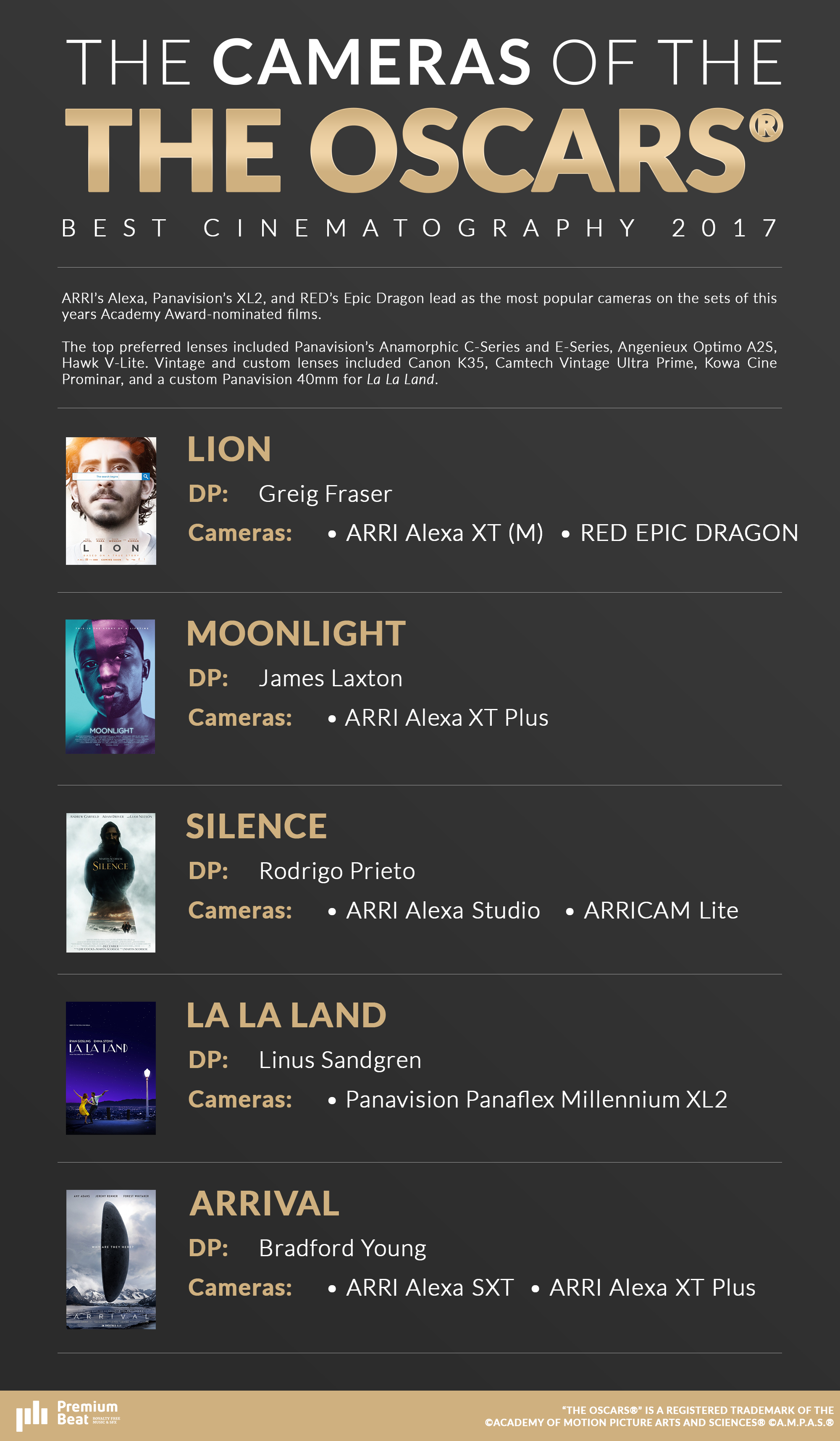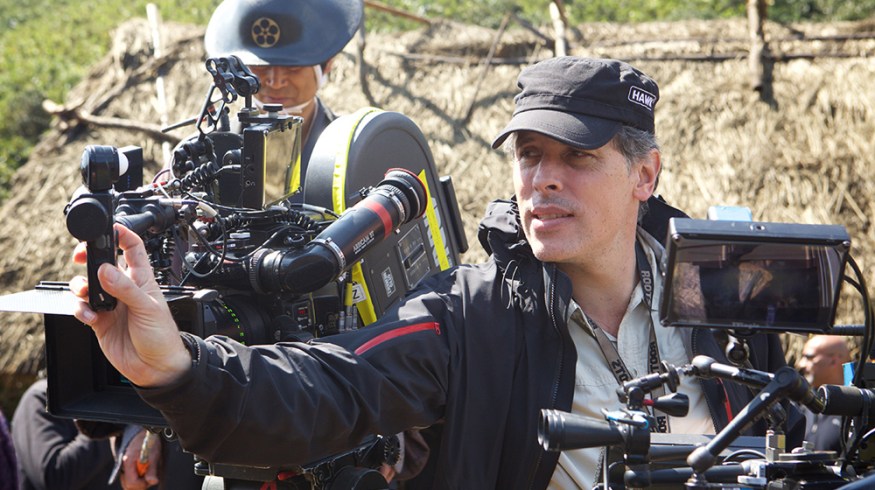
The Cameras and Lenses Behind 2017 Oscar-Nominated Films
Take a look at the gear and glass behind this year’s Academy Award-nominated films, and get the behind-the-scenes scoop from the filmmakers themselves.
Top image: Rodrigo Prieto on the set of Silence via Kodak
When it comes to filmmaking, it doesn’t really matter what gear you have — as long as you have a great story. That said, if you have a story so good that the Academy likes it, it certainly doesn’t hurt to have nice equipment too.
Here are the cameras and lenses behind many of the most popular 2017 Oscar nominees.
La La Land

Image: Damien Chazelle via Summit Entertainment
Oscar Nominations: 14, including Best Picture, Best Director, Best Cinematography, Best Film Editing
Director: Damien Chazelle
Director of Photography: Linus Sandgren
Camera: Panavision Panaflex Millennium XL2
Lenses: Panavision Anamorphic (C Series, E Series), Custom Panavision 40mm Anamorphic
Format: Film — 35mm (Kodak Vision3 500T 5219, Kodak Vision3 250D 5207), 16mm (Kodak Vision3 500T 7219)
Aspect Ratio: 2.55 : 1
In an interview with MovieMaker, Linus Sandgren, FSF talks about shooting on film with anamorphic lenses.
Because of what Damien wanted to do with this film… he felt that the film had to be shot in the scope format, anamorphic.
I felt it would be more appropriate to shoot it in 2.55 CinemaScope like they did with A Star is Born, for example, and films like that back in the 1950s, before the standard became 2.40: 1, so that’s how the 2.55 aspect ratio came up. It was really an homage to old Hollywood.
Damien really wanted to shoot on film because we wanted to capture as much rich color from the sets as possible.
It’s all shot on 35mm, but there’s a sequence shot on 16mm anamorphic. We agreed that Panavision would have the lenses for us that also spoke to us more as a classic Hollywood cinemascope lens.
We went with Panavision XL2’s camera with anamorphic C series and E series primes.
The camera then needed to move very tightly in or very wide, which would have caused problems with anamorphic lenses because they normally go three feet for close focus. So we had Panavision make a special 40mm anamorphic lens for the purpose of being able to go close to things. They made a special lens for us that had a much closer focus, so that we could get closer to hands and stuff and then pull out to wide shots.
Read the entire Sandgren interview on MovieMaker.
Moonlight
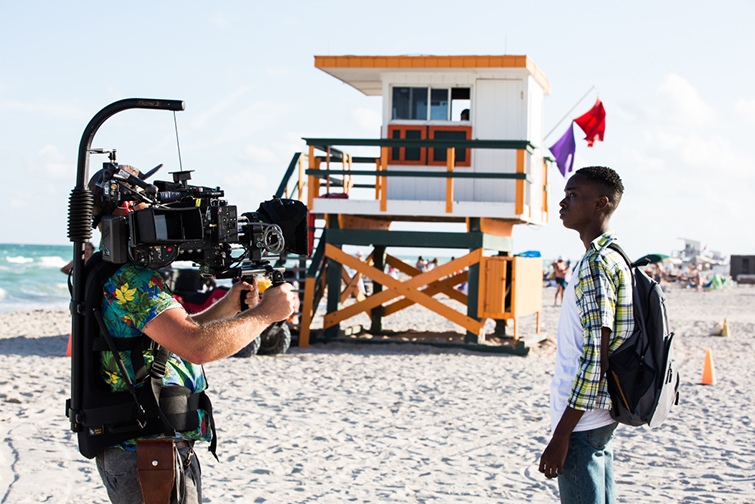
Oscar Nominations: 8, including Best Picture, Best Director, Best Cinematography, Best Film Editing
Director: Barry Jenkins
Director of Photography: James Laxton
Camera: ARRI ALEXA XT Plus
Lenses: Hawk V-Lite, Angenieux Optimo A2S
Format: Digital — ProRes
Aspect Ratio: 2.35 : 1
Cinematographer James Laxton, ASC talked with Filmmaker Magazine about his simple camera setup.
It was entirely a one-camera show. There was never a B-camera on the job. I operated the majority of the show except for the Steadicam sequences.
We chose the Hawks [V-Lite Lenses] because they provided the most applicable rendering of what we were looking for. They’re very sharp lenses and also very contrasty lenses. Those are two qualities we were interested in. There’s a trend in film right now to have a low-contrast look, but we wanted to emphasize contrast.
We [recorded in] ProRes. In our testing we found that the benefits of shooting Raw didn’t necessarily apply to what this film needed. The ALEXA’s latitude (when shooting ProRes) was enough without going down the post-production path with Raw.
Another factor for us was how long we would have on the cards. Working with child actors and working with some people who were acting for the first time on screen, we wanted to be able to keep rolling and keep rolling to make sure we gave them the space to work the performances out. Sometimes on set there’s a momentum that you have when you keep going and going. And sometimes you can keep that momentum by not cutting in between takes and just re-setting, rather than cutting, having the AD call “roll camera,” bringing the slate in, and all these other things that can hurt an actor’s momentum.
Laxton and colorist Alex Bickel talked to IndieWire about the films look and LUTs.
The first chapter was set to emulate Fuji film stock, which according to Bickel, is a little warmer and brings out a lot of texture in the skin tone. The third chapter used a modified Kodak stock which — is less “restrained” and provides more pop and shine to the image.
The most distinct looking chapter of Moonlight is the second, which Bickel credits to the old Agfa film stock it was set to mirror. The long retired German film stock was known for adding a cyan to the images highlights, which is what gives the middle section of Moonlight its greenish-blue hue.
Regarding monitoring the color, Laxton told Filmmaker Magazine:
On set we were just monitoring with Rec709. There can be a great advantage sometimes to having a DIT provide LUTs and start that base coloring process, but for this project and the pace we needed to work at, just monitoring Rec709 seemed like a simple and fast workflow for us to make sure we were in the right ballpark, knowing full well I would be spending time with Alex Bickel in the Digital Intermediate to polish and enhance the look of the film.
If we were doing something where we wanted a more desaturated look we probably would’ve changed our workflow to suit those needs, but for Moonlight using (Rec709) got us in the realm we were looking for. For me, that’s all I need on set. I’m not one to sit in a DIT booth and make minor adjustments. What I feel my role is on set is to provide a dense negative knowing later in the DI we’ll refine the images.
Read more about the cinematography and color on IndieWire and interview on Filmmaker Magazine.
Arrival
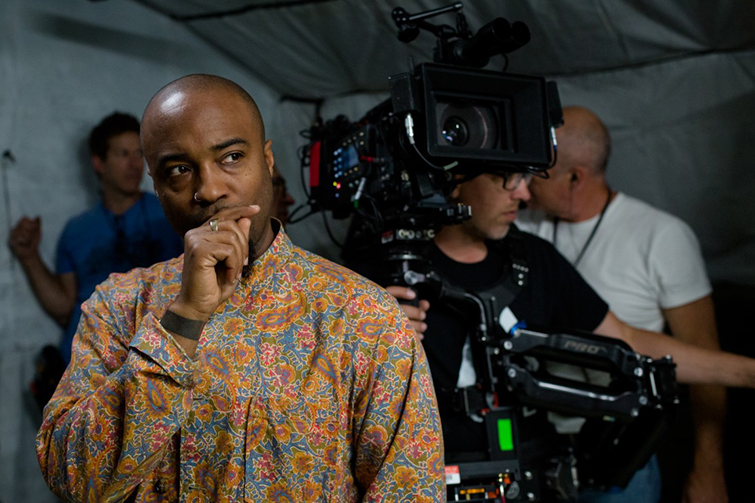
Image: Bradford Young via Paramount Pictures
Oscar Nominations: 8, including Best Picture, Best Director, Best Cinematography, Best Film Editing
Director: Denis Villeneuve
Director of Photography: Bradford Young
Cameras: ARRI ALEXA XT M, ARRI ALEXA XT Plus, ARRI ALEXA SXT
Lenses: Camtech Vintage Ultra Prime, Kowa Cine Prominar, Zeiss Super Speed
Format: Digital — ARRIRAW
Aspect Ratio: 2.35 : 1
Bradford Young, ASC turned to ARRI’s ALEXA line for Arrival. Here’s a excerpt from his interview with No Film School.
We shot with the ALEXA XST. I shot with two different kinds of lenses: some vintage Ultra Primes from CamTec, and I also used Super Speeds. Denis had really positive, great results with the work he’s done with Roger [Deakins] and I’ve slowly begun to really, really respect what we’re allowed to do with digital. It has so many virtues.
IndieWire dove into Young’s process:
Visually, using the ALEXA XT, Young treated the mission to find out the meaning of the arrival as mostly a mundane-looking procedural.
By contrast, Louise’s time-bending moments, using the lighter and more mobile ALEXA M for hand-held shots, resemble warm, naturalistic portraitures.
“I went for cooler colors when I wanted Amy to feel worn down. We tried to pull back on that a little bit, but then Denis stopped me in the [color timing] and told me not to be so concerned about skin tone and let her be pasty, let her exist in that melancholy space, let us feel that visually.”
With regards to the camera’s movement in the film, Young told No Film School:
I’ve always been apprehensive about camera movement, because I didn’t start off making films where you have dollies and technocranes and Steadicams. We couldn’t afford to have that stuff. When I use a dolly or a camera movement, I always want it to be as subtle and as understated as possible. With a lot of my work now, I try to create a sort of delicacy to how the camera moves.
Read more about Young’s work on IndieWire and read his interview with No Film School
Lion

Image: Greig Fraser, Rita Roy, Sunny Pawar, and Garth Davis via Movies Film Cinema
Oscar Nominations: 6, including Best Picture, Best Cinematography
Director: Garth Davis
Director of Photography: Greig Fraser
Cameras: ARRI ALEXA XT, ARRI ALEXA XT M, RED EPIC DRAGON
Lenses: Unknown
Format: Digital
Aspect Ratio: 2.35 : 1
Greig Fraser, ASC, ACS interviewed with No Film School, where the DP talked about his support gear on location in India.
The gimbal was a godsend for the moving stuff in India because it was the perfect height.
We could get it to [Saroo’s] height, whereas Steadicam wasn’t really a viable option at that height. And then we had a RED DRAGON on the drone.
Read the whole interview at No Film School.
Hell or High Water
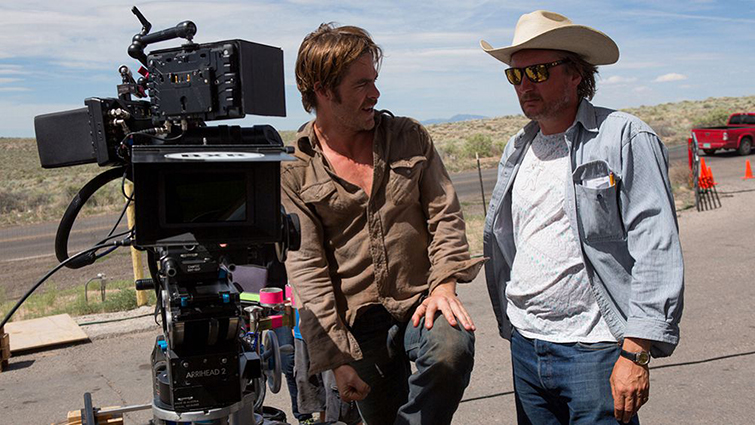
Image: Chris Pine and David Mackenzie via Empire
Oscar Nominations: 4, including Best Picture, Best Film Editing
Director: David Mackenzie
Director of Photography: Giles Nuttgens
Camera: ARRI ALEXA XT Studio
Lenses: Hawk V-Lite, Angenieux Optimo A2S
Format: Digital — ARRIRAW
Aspect Ratio: 2.35 : 1
Giles Nuttgens, BSC spoke with Studio Daily about his shoots on the set of Hell or High Water.
10 hours of continuous shooting, no large, controlled monitors on set, no producers on set, no cell phones or chairs on set, no clapper boards, and a constant turnover (about five times a day) of dailies to their nearby edit suite, where they would retire at the end of each shooting day to put their heads together.
Their purpose at that point, Nuttgens insists, was rarely to discuss “did we get the sequence, but rather, did the material have the right tone? Do we need adjustments, not particularly to lighting or framing, but more to mise en scène — whether there is anything we can do to match up to our original intentions before we get to set. That process is so invaluable.”
Read the entire piece on Studio Daily.
Hidden Figures
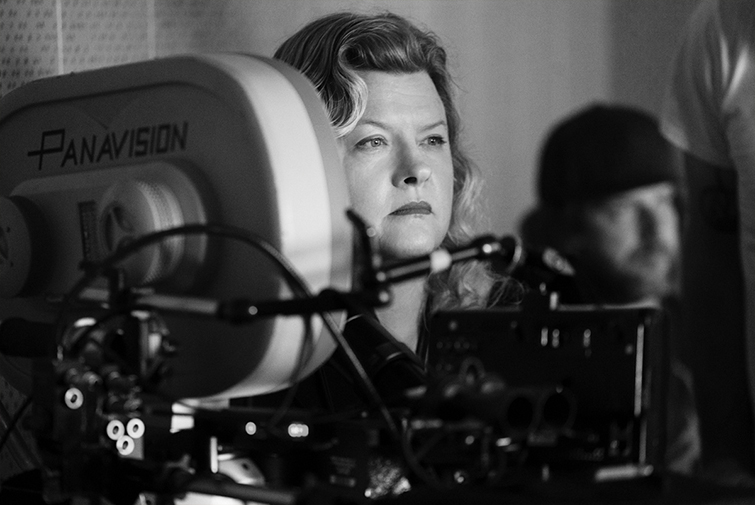
Image: Mandy Walker via ICG Magazine
Oscar Nominations: 3, including Best Picture
Director: Theodore Melfi
Director of Photography: Mandy Walker
Camera: ARRIFLEX 416, Panavision Panaflex Millennium XL2
Lenses: Panavision Ultra Speed MKII, Panavision Primo (E-Series, T-Series, ATZ), Unknown Canon
Format: Film — 35mm and 16mm (Kodak 100D, 250D, 500T)
Aspect Ratio: 2.35 : 1
Regarding the Hidden Figures camera movement, A-Camera and Steadicam Operator Jason Elson told ICG Magazine:
Movement was kept to a minimum. There were no unmotivated camera moves unless we were moving with the actors. For dialogue scenes, to preserve the eye lines, we would swing a lens on the A-camera rather than try and force two cameras together at the same time, compromising the angles.
Mandy Walker, ASC, ACS went on to talk about the color capture:
The look really resembles Kodachrome more than anything else. Production Designer Wynn Thomas and Costume Designer Renee Kalfus worked with us to create the color palette, texture and images. Color and saturation in lighting was carefully planned to support each location and the story of what the women were going through in each moment.
We wanted to make Katherine (Taraji P. Henson) a jewel in a sea of white men, in white shirts, in a gray room. We made sure she popped with her colored outfits and bright red lipstick
Read more about Walker and her crew on the International Cinematographers Guild Magazine site.
Manchester by the Sea
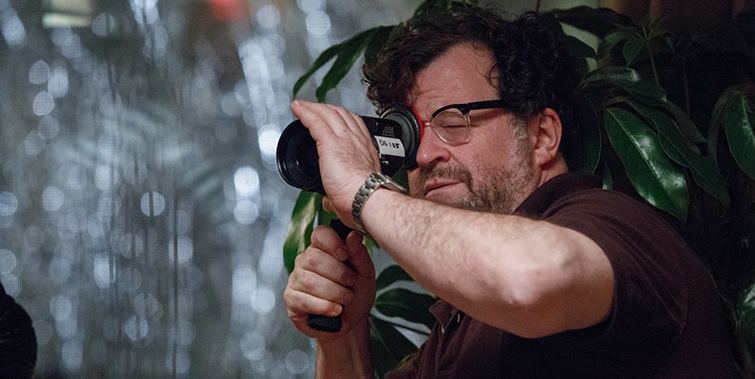
Image: Kenneth Lonergan via Post Perspective
Oscar Nominations: 6, including Best Picture, Best Director
Director: Kenneth Lonergan
Director of Photography: Jody Lee Lipes
Camera: ARRI ALEXA XT
Lenses: Canon K35, Angenieux Optimo
Format: Digital — ARRIRAW
Aspect Ratio: 1.85 : 1
Director/Writer Kenneth Lonergan spoke to Filmmaker Magazine about his process of writing this film for John Krasinski and Matt Damon until eventually directing the film himself years later.
With each movie, I’ve become more directorial in the way I think about the scripts when I’m writing them. I think I understand what’s going to be happening on the set now in a way I didn’t before.
For instance, there’s a lot of driving scenes in the movie. I noticed this, and I thought, “Gee, I wonder if all these scenes should be driving?” The towns are separated, and the kid doesn’t have a license. It’s in the middle of winter. It makes sense for their relationship. I thought, “I’ll let the director figure out an interesting way to shoot all these driving scenes.” Then when I became the director, we just didn’t have an interesting way to shoot the driving scenes, so we just did our best and the actors took care of it by acting well, and it turned out okay.
But I was a little anxious about that, and if I had known I was going to be directing it from the beginning, I might have developed a bit more of a visual concept.
Read the whole interview on Filmmaker Magazine.
Hacksaw Ridge
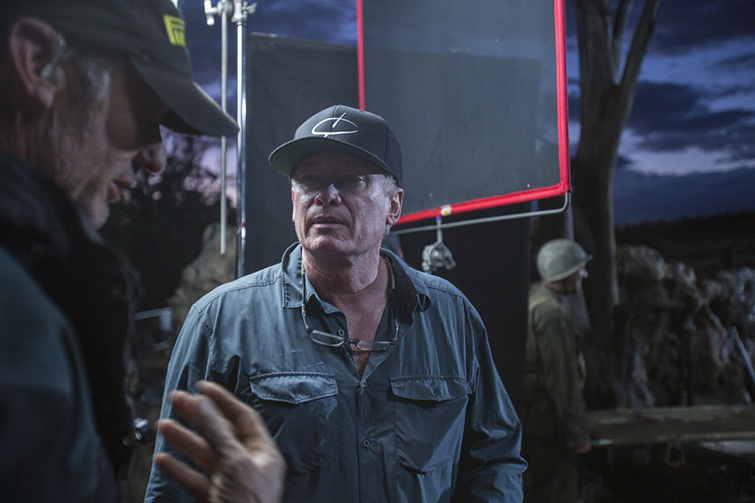
Image: Simon Duggan via Panavision
Oscar Nominations: 6, including Best Picture, Best Director, Best Film Editing
Director: Mel Gibson
Director of Photography: Simon Duggan
Camera: ARRI ALEXA XT Plus, RED EPIC DRAGON, Blackmagic Pocket Cinema Camera
Lenses: Panavision Primo, Primo V, Leica Summilux-C, Angenieux Optimo
Format: Digital — ARRIRAW
Aspect Ratio: 2.35 : 1
Simon Duggan, ASC, ACS spoke with IndieWire about shooting the war epic.
Everything was quite contained, including the battlefield, and we tried to simplify down how much we saw and really focused on the performances and stayed really tight to the storytelling.
To create the tight intensity, the second-unit placed Blackmagic pocket cinema cameras on stuntmen running through explosions.
Regarding the three main battle sequences, Duggan says
I tried to make the three sequences different by starting with the opening battle sequence with just slightly less saturation than what we saw in the West Virginia barracks.
The second one I tried to pull a lot of color out and the third one we pulled even more color out, so it was a gradual turning toward black and white.
Read the whole interview on IndieWire.
Fences
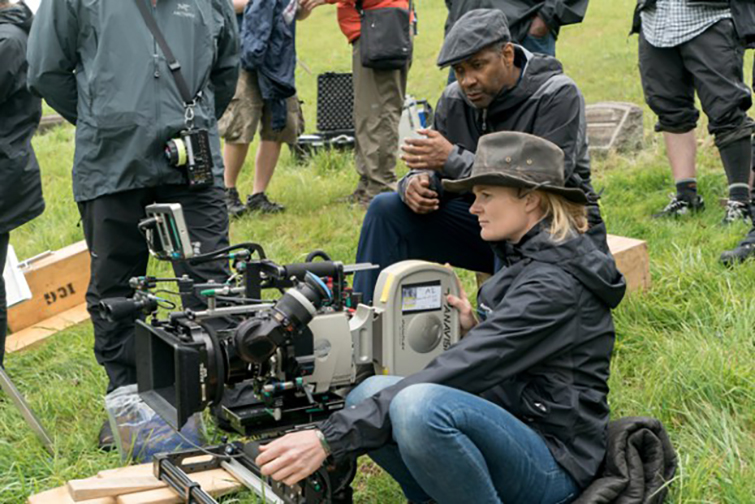
Image: Charlotte Bruus Christensen and Denzel Washington via MovieMaker
Oscar Nominations: 4, including Best Picture
Director: Denzel Washington
Director of Photography: Charlotte Bruus Christensen
Camera: Panavision Panaflex Millennium XL2
Lenses: Panavision C-Series, ATZ and AWZ2
Format: Film — 35 mm (Kodak Vision3 50D 5203, Vision3 250D 5207, Vision3 200T 5213, Vision3 500T 5219)
Aspect Ratio: 2.35 : 1
In her interview with MovieMaker Magazine, Chartlotte Bruus Christensen talked about her choice to shoot on film.
There were a lot of people asking me, “Why do you shoot 35mm? Why don’t you support the digital market, because it’s obviously going to take off?” But we were both like, “Well, at the moment, film is still available, and they’re opening a lab here in New York…” and, I don’t know, I love that medium. I think it’s truthful. It’s like you shoot in digital. Then you go into post-production and try to make it look like film. Why don’t you just shoot on film?
Regarding all the camera movement at the beginning of the film, Christensen states,
It’s a Steadicam that I’m carrying and I’m running. Basically from the minute [snaps her finger] you open the movie, they talk, and it’s like music. Denzel kept saying, “My direction to you is this is like music, music.” I had to keep that in my mind as I moved. And then when we come to the backyard, suddenly, we feel a little bit theatrical again and we put the camera exactly where the audience was. Now we just stay there. So up until Viola comes in the camera’s been moving. And then when she comes into the scene the camera is trained on her to get every emotion.
Read the entire interview on MovieMaker Magazine.
Silence
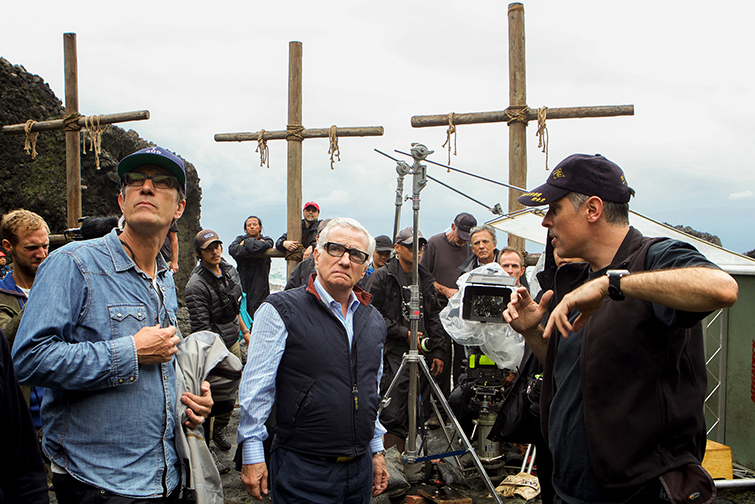
Image: Martin Scorsese, Rodrigo Prieto and crew via The Playlist
Oscar Nominations: Best Cinematography
Director: Martin Scorsese
Director of Photography: Rodrigo Prieto
Cameras: ARRI ALEXA Studio, ARRICAM Lite
Lenses: Zeiss Master Anamorphic, Angenieux Optimo Lenses
Format: Digital — ARRIRAW, Film — 35mm (Kodak Vision3 250D 5207, Vision3 200T 5213, Vision3 500T 5219)
Aspect Ratio: 2.35 : 1
Rodrigo Prieto, ASC, AMC sat down with No Film School to discuss his work on Silence.
There’s a progression of color in the film. We were inspired by baroque painters, starting off in cooler tones—blues and cyans—and going towards the green of nature, as it’s an important character to the story. Then we transitioned into a more Japanese feel, if I may. We went with more amber, yellow, and gold hues that would represent the same Japanese screen art during the Edo period.
We agreed immediately we wanted to shoot on film. We actually shot all the night scenes digitally to capture them in candlelight or the dusk scenes with torches. It was the best of both worlds. We used film for what it’s best at—skin tone and nuance on faces and color of the landscape—then digital for low-light situations.
Read the entire interview on No Film School.
Nocturnal Animals
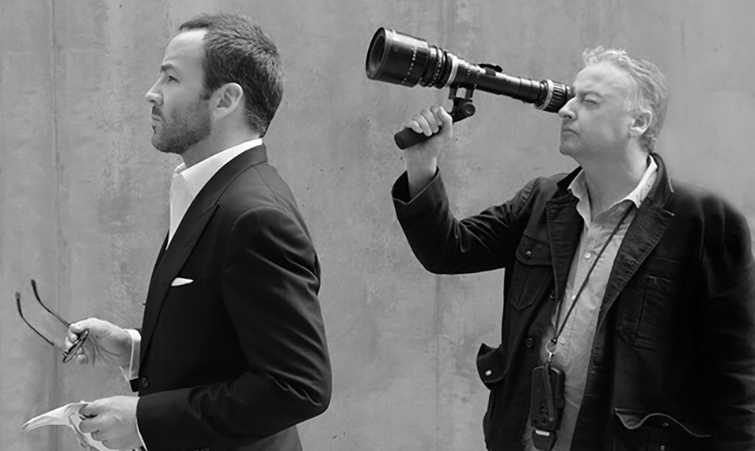
Image: Tom Ford and Seamus McGarvey via Screen Daily
Oscar Nominations: Best Supporting Actor
Director: Tom Ford
Director of Photography: Seamus McGarvey
Camera: Panavision Panaflex Millennium XL2
Lenses: Panavision Primo Lenses
Format: Film — 35mm (Kodak Vision3 200T 5213, Vision3 500T 5219)
Aspect Ratio: 2.35 : 1
Seamus McGarvey, ASC, BSC spoke to IndieWire about his work on both Nocturnal Animals and The Accountant.
Film gives you the flexibility to go into any direction, which was important for these two films…
Nocturnal Animals features an imagined story within one of the character’s minds.
It had to have a cinematic feel but a psychological one too. That gave us a lot of scope and leaps of faith and playing with imagery.
Film allowed us to play with leaping forward into the over-saturated desert, using the codes of a Western or color noir. And a lot of it was shot at night and we were blessed with a crisp, early fall.
I found that film and film cameras are more robust and able to deal with the vagaries of temperature and conditions. Again, when you came to the DI [digital intermediate], we have grain, we have contrast, but yet when we want to open up the negative and create a paler side, the latitude is there for the earlier scenes in her house.
Read more of McGarvey’s interview on IndieWire.
Academy Awards for Scientific and Technical Achievements

The Academy of Motion Picture Arts and Sciences has already awarded Scientific and Engineering Academy Plaques to ARRI, RED Digital Cinema, and Sony.
ARRI ALEXA
To ARRI for the pioneering design and engineering of the Super 35 format ALEXA digital camera system. With an intuitive design and appealing image reproduction, achieved through close collaboration with filmmakers, ARRI’s ALEXA cameras were among the first digital cameras widely adopted by cinematographers.
RED EPIC
To RED Digital Cinema for the pioneering design and evolution of the RED EPIC digital cinema cameras with upgradeable full-frame image sensors. RED’s revolutionary design and innovative manufacturing process have helped facilitate the wide adoption of digital image capture in the motion picture industry.
Sony F65 CineAlta
To Sony for the development of the F65 CineAlta camera with its pioneering high-resolution imaging sensor, excellent dynamic range, and full 4K output. Sony’s unique photosite orientation and true RAW recording deliver exceptional image quality.
Read the rest of the Scientific and Technical Achievement winners from the Oscars
Here’s a sharable infographic that dives into the gear behind 2017’s Best Cinematography Oscar Nominees.
The Oscars® and Academy Awards® are Registered Trademarks of the ©Academy of Motion Picture Arts and Sciences® – ©A.M.P.A.S.®


